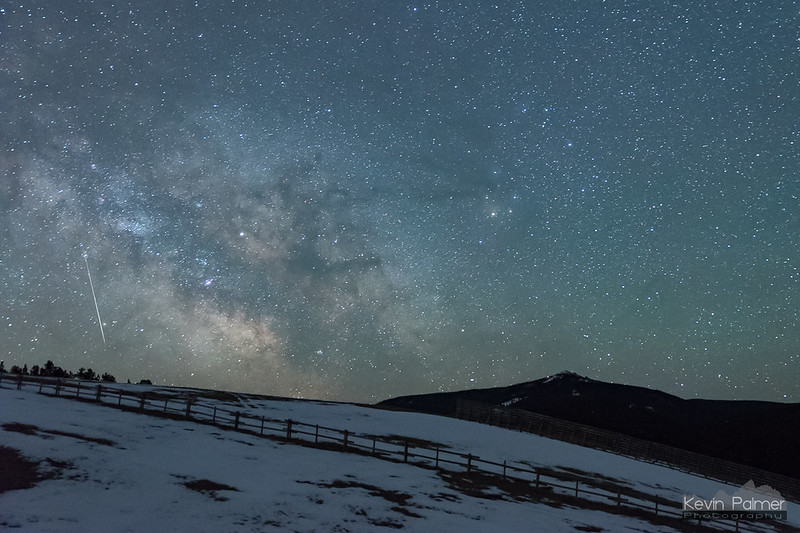Stuck at home with clear skies? We’re all in a similar situation, as the ongoing pandemic sees most of the worldwide amateur astronomy community observing from home or from their backyard. One astronomical sure-fire event coming up this week requires no special equipment, just a set of working ‘Mk-1 eyeballs’ and a clear sky: the April Lyrids.
Continue reading “Catching the Peak of the 2020 April Lyrids”Get Ready for the Lyrid Meteor Shower: Our Complete Guide for 2014
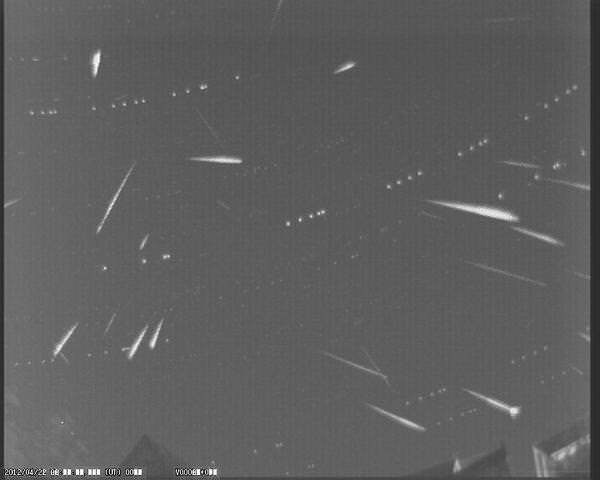
The month of April doesn’t only see showers that bring May flowers: it also brings the first dependable meteor shower of the season. We’re talking about the Lyrid meteors, and although 2014 finds the circumstances for this meteor shower as less than favorable, there’s still good reason to get out this weekend and early next week to watch for this reliable shower.
The Lyrid meteor shower typically produces a maximum rate of 10-20 meteors per hour, although outbursts topping over a hundred per hour have been observed on occasion. The radiant, or the direction that the meteors seem to originate from, lies at right ascension 18 hours and 8 minutes and declination +32.9 degrees north. This is just about eight degrees to the southwest of the bright star Vega, which is the brightest star in the constellation of Lyra the Lyre, which also gives the Lyrids its name.
Fun fact: this radiant actually lies juuusst across the border of Lyra in the constellation of Hercules… technically, the “Lyrids” should be the “Herculids!” This is because the shower was identified and named in the 19th century before the International Astronomical Union officially adopted the modern layout we use for the constellations in 1922.
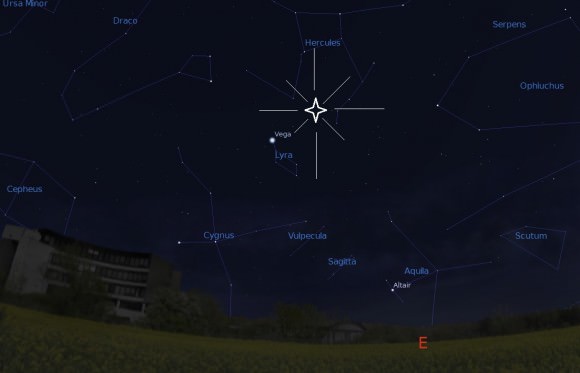
The source of the Lyrids was tracked down in the late 1860s by mathematician Johann Gottfried Galle to Comet C/1861 G1 Thatcher, the path of which came within 0.02 Astronomical Units (A.U.s) of the Earth’s orbit on April 20th, 1861, just six weeks before the comet reached perihelion. Comet G1 Thatcher is on a 415 year orbit and won’t return to the inner solar system until the late 23rd century.
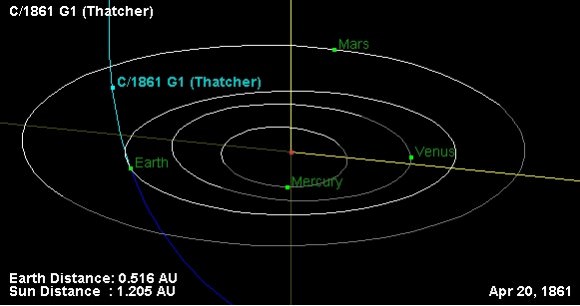
But we can enjoy the dust grains it left in its wake as they greet the Earth to burn up in its atmosphere every April. The activity of the Lyrids typically spans April 16th to the 25th, with a short 24 hour peak above a ZHR of 10 on April 22nd-23rd. Thus, like the short duration Quadrantids in January, timing is critical; if you happen to observe this shower before or after the peak, you may see nothing at all. This year, the key mornings will be Tuesday, April 22nd, and Wednesday April 23rd. The wide disparity of predictions for the exact arrival of the peak of the Lyrids, as quoted in differing sources speaks to just how poorly this meteor shower is understood. Scanning various reliable resources, we see times quoted from April 22nd at 4:00 Universal Time (UT) from the American Meteor Society, to 17:00 UT on the same date for the Royal Canadian Astronomical Society, to April 23rd at 17:45 UT from Guy Ottewell’s venerable 2014 Astronomical Calendar!
Definitely, more observations of this curious shower are needed.
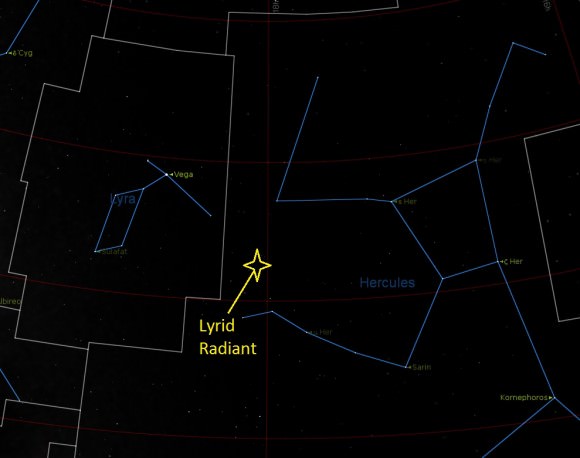
Now for the bad news. This year finds the light-polluting Moon in nearly its worst location possible for a meteor shower. Remember this week’s total lunar eclipse? Well, the Moon is now waning gibbous and will reach last quarter phase at 7:52 UT/3:52 AM EDT on April 22nd, and will thus be rising at local midnight and be high in the sky towards dawn. The Lyrid radiant rises at 9:00 PM this week for observers around 40 degrees north and rides highest at 6:00 AM local, about 45 minutes before sunrise.
Looking at the International Meteor Organization’s historical data, here’s what the Lyrids have done over the past few years:
2013- ZHR 22, Moon phase= 88% illuminated, waxing gibbous.
2012– ZHR 25, Moon phase= 2% illuminated, waxing crescent.
2011- ZHR 20, Moon phase= 73% illuminated waning gibbous.
2010- ZHR 32, Moon phase= 62% illuminated waxing gibbous.
2009- ZHR 15, Moon phase= 7% illuminated waning crescent.
A “ZHR” is the Zenithal Hourly Rate, a theoretical maximum number of meteors that an observer could expect to witness under dark skies if the radiant was straight overhead. Note that 2011 had similar circumstances with respect to the Moon as this year, so don’t despair! The Lyrids are approaching the Earth from nearly perpendicular in its orbit and have a head on velocity of about 48 kilometres per second, respectable for a meteor shower. They also present a higher-than-average number of fireballs, with about a quarter leaving persistent trains.
Outbursts have also occurred in 1803, 1849, 1850, 1922, 1945 and 1982. United States observers based in Florida and Colorado noted a brief ZHR approaching 100 per hour back in 1982 under especially favorable New Moon conditions.
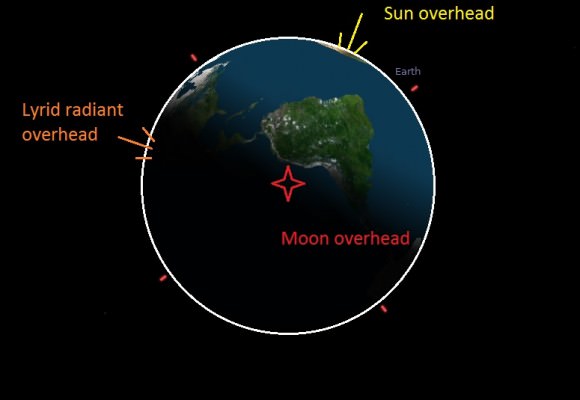
Ironically, the Lyrids are also one of the oldest meteor showers identified from historic records. In fact, Galle actually traced the shower back to Chinese records dating all the way back to March 16th 687 BC, which describes “Stars (that) dropped down like rain…” clearly, the Lyrids were considerably more active in ancient times.
More recently, attempts were made to link the 2012 Sutter’s Mill meteorite fall to the Lyrids, which were underway at the time. This turned out to be a case of “meteor-wrong,” however, as described by Geoff Notkin of the Meteorite Men who noted that no meteorite fall has ever been linked to a meteor shower, though he does get lots of calls whenever news of a big meteor shower hits the press.
A good strategy for beating the Moon includes blocking it behind a hill or building while observing. Early morning is the best time to watch for Lyrids — or most any meteor shower for that matter — as you’re then on the half of the Earth facing forward into the meteor stream. And you don’t have to face toward the radiant to see Lyrid meteors, as they can appear anywhere in the sky.
With the advent of DSLRs, photographing meteors is easier than ever before. All you need to do is use a wide angle lens and take periodic time exposures of the sky. Do a few early test shots to get the combination of f-stop, ISO and shutter speed just right for current sky conditions, and be sure to review those images on a full size monitor afterward: nearly every meteor we’ve captured turned up in post-review only.
Looking to contribute to our understanding of the Lyrid meteors? Simply count the number you see and the location and length of your observation and send your report into the International Meteor Organization. And don’t forget to tweet those Lyrids to #Meteorwatch!
…and there’s more to come. Next month, a true “wildcard outburst” may be in the offing from Comet 209P/LINEAR on May 26th… can you say “Camelopardalids?”
Stay tuned!
The Curious History of the Lyrid Meteor Shower
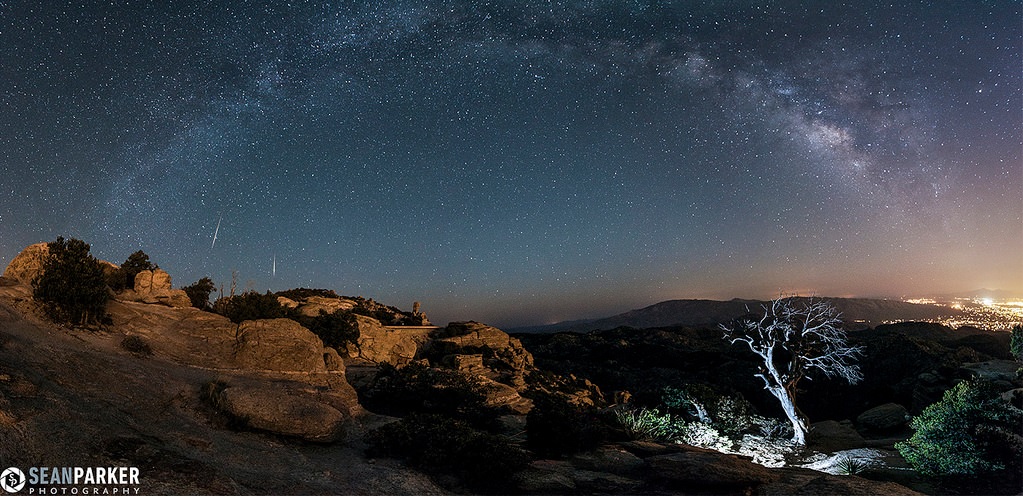
Today we residents of planet Earth meet up with a meteor stream with a strange and bizarre past.
The Lyrid meteors occur annually right around April 21st to the 23rd. A moderate meteor shower, observers in the northern hemisphere can expect to see about 20 meteors in the early morning hours under optimal conditions. Such has been the case for recent years past, and this year’s presence of a waxing gibbous Moon has lowered prospects for this April shower considerably in 2013.
But this has not always been the case with this meteor stream. In fact, we have records of the Lyrids stretching back over the past 2,600 years, farther back than any other meteor shower documented.
The earliest account of this shower comes from a record made by Chinese astronomers in 687 BC, stating that “at midnight, stars dropped down like rain.” Keep in mind that this now famous assertion that is generally attributed to the Lyrids was made by mathematician Johann Gottfried Galle in 1867. It was Galle along with Edmond Weiss who noticed the link between the Lyrids and Comet C/1861 G1 Thatcher discovered six years earlier.
Comet Thatcher was discovered on April 5th, 15 days before it reached perihelion about a third of an astronomical unit (A.U.) from the Earth. Comet Thatcher a periodic comet on a 415 year long orbital period.
But in the early to mid-19th century, the very idea that meteor showers were linked to comets or even non-atmospheric phenomena was still hotly contested.
One singular event more than any other triggered this realization. The Leonid meteor storm of 1833 in the early morning hours of November 13th was a stunning and terrifying spectacle for residents of the U.S eastern seaboard. This shower produces mighty outbursts, often topping a Zenithal Hourly Rate (ZHR) of over a 1,000 once every 33 to 34 years. I witnessed a fine outburst of the Leonids from Kuwait in 1998, and we may be in for a repeat performance from this shower around 2032 or 2033.
There is substantial evidence that the Lyrids may also do the same at an undetermined interval. On April 20th 1803, one of the most famous accounts of a “Lyrid meteor storm” was observed up and down the United States east coast. For example, one letter to the Virginia Gazette states;
“From one until three, those starry meteors seemed to fall from every point in the sky heavens, in such numbers as to resemble a shower of sky rockets.”
Another account published in the Raleigh, North Carolina Register states that:
“The whole hemisphere as far as the extension of the horizon seemed illuminated; the meteors kept no particular direction but appeared to move in every way.”
A study of the 1803 Lyrid outburst by W.J. Fisher cites over a dozen accounts of the event and is a fascinating read. Viewers were also primed for the event by the dramatic Leonid storm of 1799 four years earlier.
Interestingly, the Moon was only one day from New phase on the night of the 1803 Lyrids. Prime meteor watching conditions.
An unrelated meteorite fall would also occur four years later over Weston, Connecticut on December 14th, 1807 as recounted by Kathryn Prince in A Professor, A President, and a Meteor. These events would place Yankee politics at odds with the origin of meteors and rocks from the sky.
An apocryphal quote is often attributed to President Thomas Jefferson that highlights the controversy of the day, saying that “I would more easily believe that two Yankee professors would lie than that stones would fall from heaven.”
While both are of cosmogenous origin, no meteorite fall has ever been linked to a meteor shower, which is spawned by dust debris from comets. For example, many in the media erroneously speculated that the Sutter’s Mill meteorite that fell to Earth on the morning of April 22nd, 2012 was in fact a Lyrid meteor.
But a Lyrid may be implicated in another unusual 19th century observation. On April 24th 1874, a professor Scharfarik of Prague, Czechoslovakia was observing the daytime First Quarter Moon with his 4” refractor. The good professor was surprised by an “Apparition on the disc of the Moon of a dazzling white star,” which was “quite sharp and without a perceptible diameter.” Possible suspects are a telescopic meteor moving towards or along the observers’ line of sight or perhaps a Lyrid impacting the dark limb of the Moon.
Moving into the 20th century, rates for the Lyrids have stayed in the ZHR=20 range, with notable peaks of 100+ per hour noted by Japanese observers in 1922 and 100 per hour noted by U.S. observers in 1982.
It should also be noted that another less understood shower radiates from the constellation Lyra in mid-June. First noted Stan Dvorak while hiking in the San Bernardino Mountains in 1966, the June Lyrids produce about 8-10 meteors per hour from June 10 to the 21st. The source of this newly discovered shower is thought to be Comet C/1915 C1 Mellish.
A June Lyrid may have even made its way into modern fiction. As recounted in a July 2004 issue of Sky & Telescope, researchers Marilynn & Donald Olson note the following line from James Joyce’s Ulysses:
“A star, precipitated with great apparent velocity across the firmament from Vega in the Lyre above the zenith.”
Joyce seems to be describing a June Lyrid decades before the shower was officially recognized. The constellation Lyra rides high in the early morning sky for mid-northern latitudes in the early summer months.
All interesting concepts to ponder as we keep an early morning vigil for the Lyrids this week. Could there be more Lyrid storms in the far off future, as Comet Thatcher reaches perihelion once again in the late 23rd century? Could more historical clues of the untold history of this and other showers be awaiting discovery?
Somewhat closer to us in time and space, Paul Wiegert of the University of Ontario has also recently speculated that Comet 2012 S1 ISON may provoke a meteor shower on January 12th, 2014. Regardless of whether ISON turns out to be the “Comet of the Century,” this could be one to watch out for!
This Weekend’s Lyrid Meteor Shower: How to See It
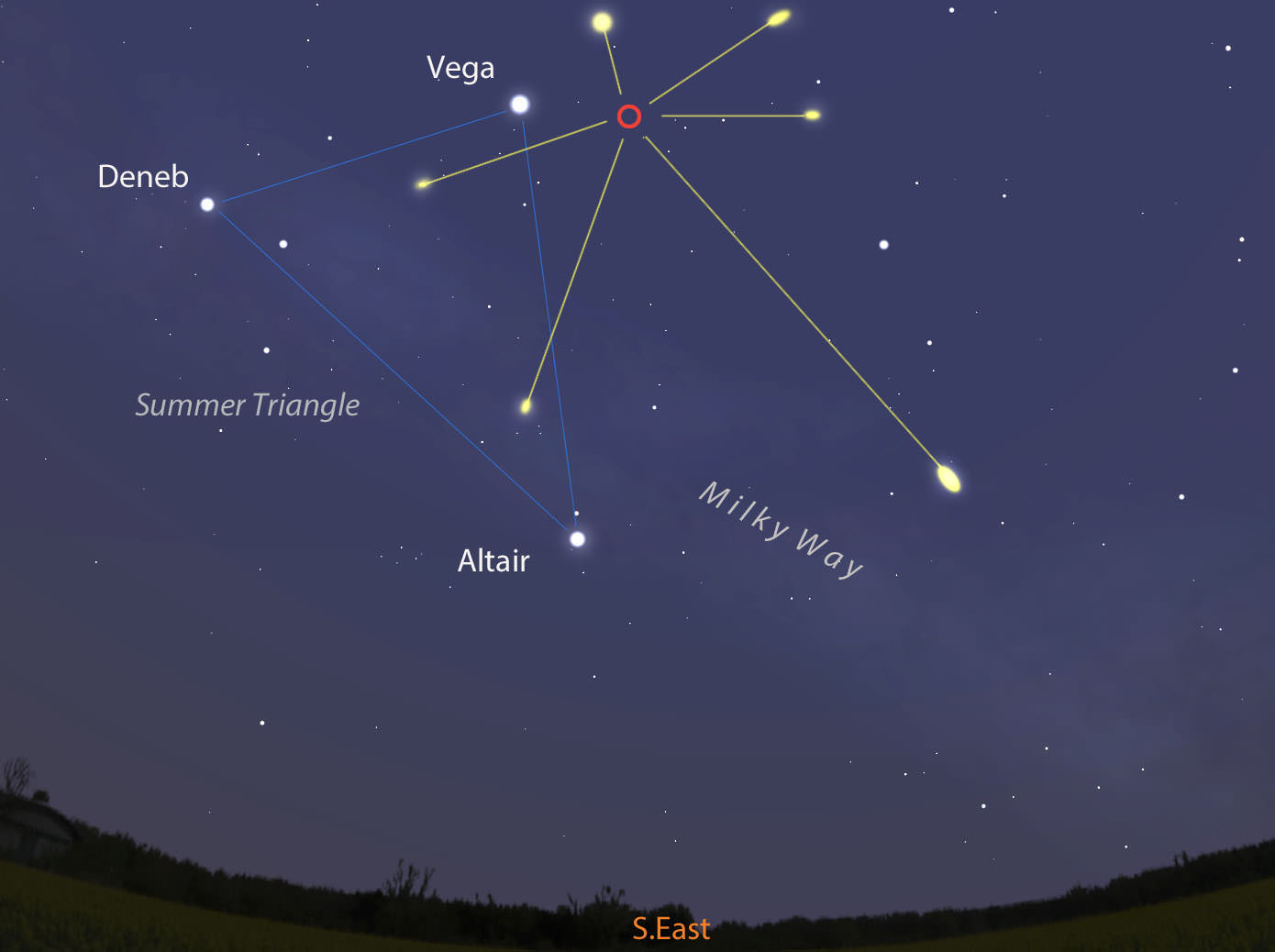
Feeling a little meteor-starved lately? Me too. It’s been a meteor shower desert since the Quadrantids of early January. That’s about to change. This weekend brings the celestial version of April showers with the annual appearance of the Lyrids.
The Lyrids ding the bell at maximum strength this weekend April 21-22 (Sunday night-Monday morning in the Americas) hurtling meteors at the modest rate of 10-20 per hour from a point in the sky not far from bright Vega in the constellation Lyra. While some showers spread their meteor crumbs over several days, the Lyrids’ peak activity lasts less than a day. The western hemisphere – particularly the western half of North America – is favored this year.
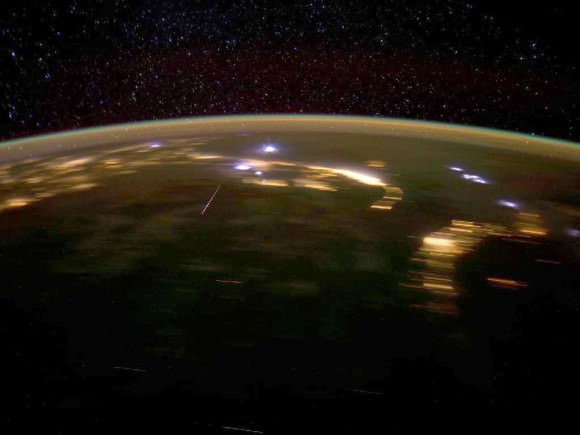
There will be a small price to pay for the show. The Lyrid radiant, the point in the sky from which the showers members radiate, rises in the east rather late – around 10:30 p.m. local time. Then there’s the bright gibbous moon, which has a habit of drowning out fainter stars and meteors alike. That makes the best time for viewing the shower after moonset or around 4 a.m. Monday morning. Since dawn begins about 5, you’ll have one good hour. That’s plenty of time to snag at least a few flaming motes of Comet Thatcher.
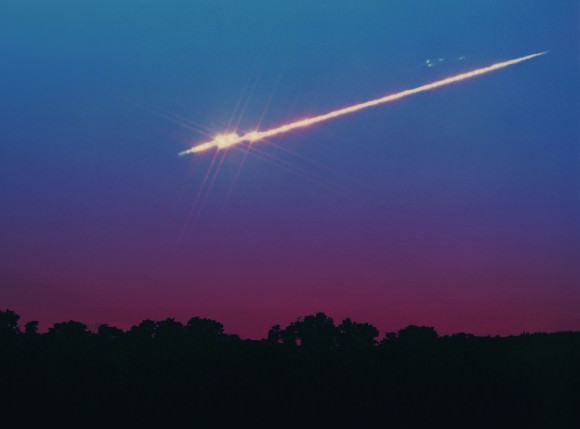
Like most meteor showers, the Lyrids have a parent and single parents are the rule. For the Lyrids, it’s Comet Thatcher, discovered on April 5, 1861, a week before the start of the Civil War, by amateur astronomer A.E. Thatcher observing from New York City. Later it was found to be linked to the Lyrid meteor shower.
Each year in late April, Earth passes through centuries of dust shed by the comet’s tail. When bits of Thatcher flotsam strike the air some 60-70 miles high, they burn up in flashes of meteoric light. Comet tears.
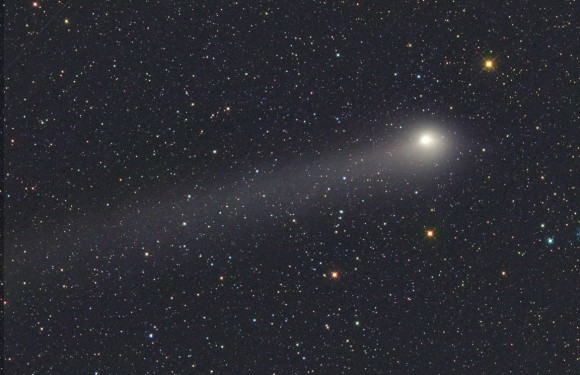
All meteors are worthy of keeping an eye on, but bear in mind that the Lyrids are no Perseids, the famed summertime shower offering up to 60 meteors per hour under dark skies. But what they lack in numbers, they make up in reliability and surprise.
Records indicate that people have been watching the Lyrids for at least 2,600 years, the longest of any shower. Our oldest descriptions come from the Chinese who penned that “stars fell like rain” on March 16, 687 BC. Apparently the shower was more active in the past and has since evolved into a minor display. But there have been occasional surprises, and that’s what keeps the Lyrids interesting.
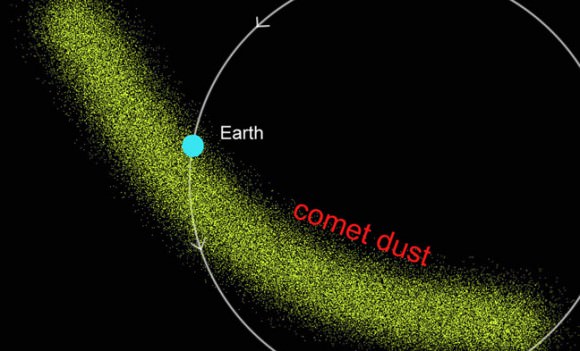
On April 20, 1803 a fire bell roused Richmond, Virginia residents from their beds to witness a similar rain of stars when up to 700 meteors per hour were seen. Other Lyrid outbursts occurred in 1922 (100 per hour), 1945 (100/hr), 1982 (90/hour). Last year’s peak hit 37 per hour from a dark sky site. Now and then, Earth encounters a thicker band of comet debris left behind by Comet Thatcher, suddenly increasing the meteor count by many times and just as suddenly dropping back to the usual 10-20 per hour.
So here’s the bottom line. Don’t expect a big blast, but do avail yourself of the leisurely pleasure of meteor watching and the possibility of seeing pieces of a comet that rounds the sun only every 415 years. Find a spot where artificial lights is at a minimum, dress warmly and head out around 3:30 a.m. Monday. Set up a comfortable lawn chair and have tea or coffee and a blanket at the ready. You’ll do well to face south or east. Now recline back to allow a fulsome view of the sky above and wait for a few well-deserved ooohs and aaahs.

